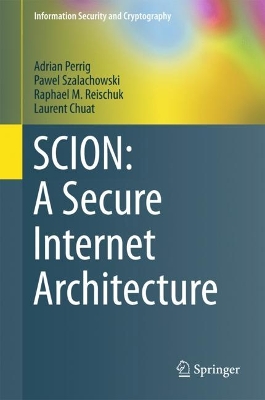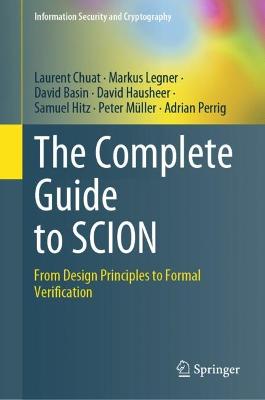Information Security and Cryptography
2 total works
SCION: A Secure Internet Architecture
by Adrian Perrig, Pawel Szalachowski, Raphael M. Reischuk, and Laurent Chuat
This book describes the essential components of the SCION secure Internet architecture, the first architecture designed foremost for strong security and high availability. Among its core features, SCION also provides route control, explicit trust information, multipath communication, scalable quality-of-service guarantees, and efficient forwarding. The book includes functional specifications of the network elements, communication protocols among these elements, data structures, and configuration files. In particular, the book offers a specification of a working prototype.
The authors provide a comprehensive description of the main design features for achieving a secure Internet architecture. They facilitate the reader throughout, structuring the book so that the technical detail gradually increases, and supporting the text with a glossary, an index, a list of abbreviations, answers to frequently asked questions, and special highlighting for examples and for sections that explain important research, engineering, and deployment features. The book is suitable for researchers, practitioners, and graduate students who are interested in network security.
The Complete Guide to SCION
by Laurent Chuat, Markus Legner, David Basin, David Hausheer, Samuel Hitz, Peter Muller, and Adrian Perrig
When the SCION project started in 2009, the goal was to create an architecture offering high availability and security for basic point-to-point communication. In the five years since the publication of SCION: A Secure Internet Architecture, this next-generation Internet architecture has evolved in terms of both design and deployment.
On the one hand, there has been development of exciting new concepts and systems, including a new global time-synchronization system, an inter-domain approach for bandwidth reservations called COLIBRI, and Green Networking, which allows combating global climate change on three fronts. On the other hand, SCION is now also in production use by the Swiss financial ecosystem, and enables participants such as the Swiss National Bank, the Swiss provider of clearing services (SIX), and all Swiss financial institutes to communicate securely and reliably with each other via the Secure Swiss Finance Network.
This unique guidebook provides an updated description of SCION's main components, covering new research topics and the most recent deployments. In particular, it presents in-depth discussion of formal verification efforts. Importantly, it offers a comprehensive, thorough description of the current SCION system:
- Describes the principles that guided SCION's design as a secure and robust Internet architecture
- Provides a comprehensive description of the next evolution in the way data finds its way through the Internet
- Explains how SCION can contribute to reducing carbon emissions, by introducing SCION Green Networking
- Demonstrates how SCION not only functions in academic settings but also works in production deployments
- Discusses additional use cases for driving SCION's adoption
- Presents the approaches for formal verification of protocols and code
- Illustrated with many colorful figures, pictures, and diagrams, allowing easy access to the concepts and use cases
Assembled by a team with extensive experience in the fields of computer networks and security, this text/reference is suitable for researchers, practitioners, and graduate students interested in network security. Also, readers with limited background in computer networking but with a desire to know more about SCION will benefit from an overview of relevant chapters in the beginning of the book.

